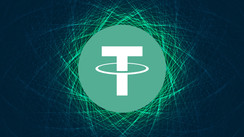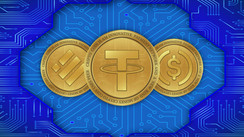In the midst of an expanding regional banking crisis in the U.S. and intensifying regulatory scrutiny on cryptocurrency firms, the digital stablecoin Tether is emerging as the least volatile asset in the crypto domain.
As investments pivot towards perceived safe havens within the cryptocurrency landscape, Tether, already leading the pack among stablecoins, has seen its market valuation skyrocket since March. Stablecoins, which are digital tokens tied to a fiat currency like the dollar, offer a semblance of stability in the volatile crypto market. Tether's value is secured by a 1-to-1 peg with a reserve of dollars and a limited supply of approximately 85 billion tokens. The coin's popularity has surged to such an extent that its peg has consistently remained above 1 since mid-April, peaking at 1.002 just last week.
AKJ global brokerage's Oslo-based founder and digital asset specialist, Anders Kvamme Jensen, suggests the banking crisis is driving "hyper-bitcoinisation"—a belief that the dollar will eventually lose all value. This has prompted investors to flock to leading cryptocurrencies like bitcoin and ether.
However, pegged stablecoins like Tether are primarily viewed as a value store and a facilitator for transactions between cryptocurrencies. They also function as collateral for derivative trades. Conor Ryder, a research analyst at Kaiko, a digital assets data provider, believes Tether's premium mirrors a growing trust in its peg and its perceived immunity from the U.S. Securities and Exchange Commission (SEC).
Tether is a property of iFinex Inc, a British Virgin Islands-registered company that also owns the Bitfinex cryptocurrency exchange. The coin's main competition, USDC, managed by Boston-based Circle, has suffered following the disclosure of its links to the failed Silicon Valley Bank and increased SEC oversight of fintech and crypto firms.
Other significant stablecoins such as Binance USD token (BUSD) have experienced a downturn after its creators announced a halt to the issuance of new tokens following U.S. regulators' classification of the asset as an unregistered security. The DAI token has struggled due to its unconventional peg to reserves that include other stablecoins and cryptocurrencies.
Jensen points out that Tether is seen as less exposed to U.S. regulations, thus posing a lower regulatory risk. Investing in Tether and Bitcoin is largely perceived as a vote against the U.S. system.
In CoinMarketCap's list of 23,891 tokens, Tether has ascended to the third spot with a market cap of $82 billion and a 6.83% market share.
Despite long-standing skepticism surrounding Tether's dollar reserve-backed peg, the stablecoin has managed to weather the storm. The entire stablecoin sector was impacted last year by events such as the collapse of crypto hedge fund Three Arrows Capital, the de-pegging of Terra USD, and the failure of crypto exchange FTX.
Ryder notes, "Tether's unique appeal lies in its status as the industry's most trusted stablecoin, offering a reliable $1 peg. It's one of the few stablecoins that can currently make this claim. In contrast, Bitcoin is seen as a safe haven against monetary debasement, representing a form of money that is 'outside' the traditional banking system."
Bitcoin itself has seen a remarkable rally, with a 73% increase this year, after facing resistance around $31,000 last month.




